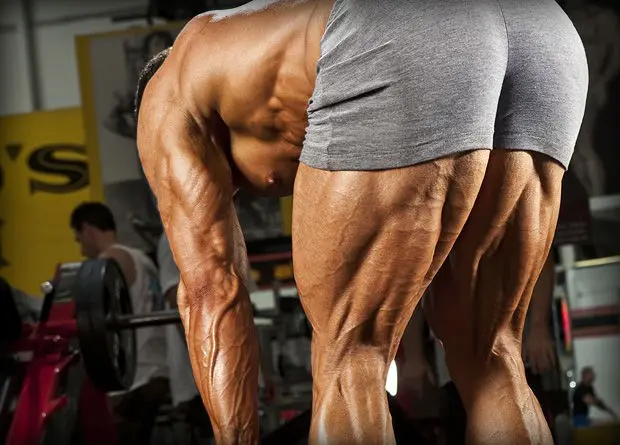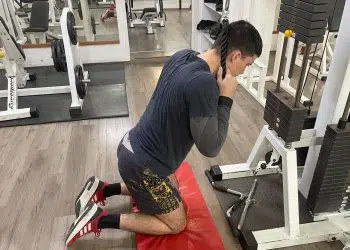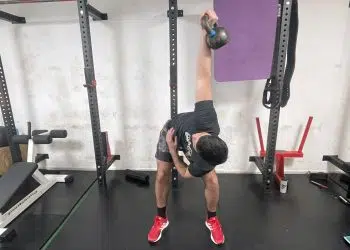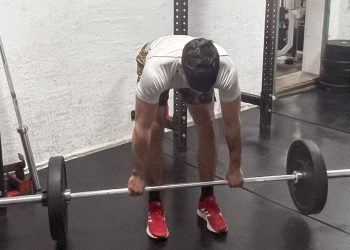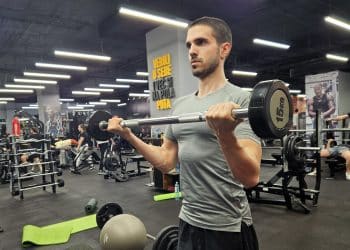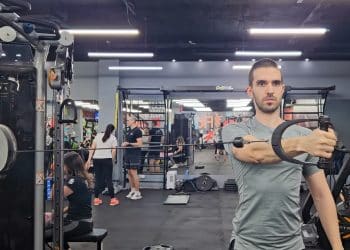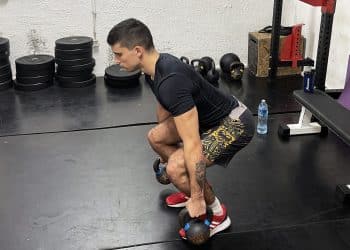The Nordic ham curl isn’t your everyday exercise. But make no mistake, it’s a darn good one for building those hamstrings and a few other posterior chain (back of the body) muscles too.
It’s a bodyweight movement similar to the leg curl, however, you’ll usually perform the eccentric or lowering portion with an assisted concentric (positive phase). It’s also different because the torso moves rather than the legs.
But the benefits are definitely present which include increased strength, hypertrophy, and even reduced injury. So we put together a helpful guide on this often ignored exercise so that you can better understand its function.
We’ll start by explaining the muscles worked before jumping into the exercise instructions, followed by the benefits, tips, variations, alternatives, and common mistakes…
Muscles Worked
The Nordic ham curl works a few different muscles although the main, target muscle is the hamstrings which are located on the posterior, opposite the quadriceps.
Hamstrings
The three muscles which make up the hamstrings are:
Level Up Your Fitness: Join our 💪 strong community in Fitness Volt Newsletter. Get daily inspiration, expert-backed workouts, nutrition tips, the latest in strength sports, and the support you need to reach your goals. Subscribe for free!
- biceps femoris
- semimembranosus
- semitendinosus
The biceps femoris has two heads that allow for knee flexion and rotation as well as hip extension.
The semimembranosus is the largest hamstring muscle which is responsible for extension and flexion of the thigh, plus rotation of the tibia.
The semitendinosus is the longest hamstring muscles responsible for extension of the thigh, rotation of the tibia, and knee flexion.
All three hamstring muscles cross both the hip and knee joint except for the short head of the biceps femoris which only crosses the knee joint.
The hamstrings play a big role in walking, running, jumping, and bending at the pelvis.
Glutes
The glute or butt muscles are also engaged during the nordic curl. The glutes are comprised of three muscles which are…
-
Gluteus maximus
-
Gluteus medius
-
Gluteus minimus
The glute maximus is the largest muscle of the butt that makes up most of the rear end appearance. It works with the hamstrings to extend and externally rotate the thigh, along with keeping the body upright.
The glute medius and minimus are lateral hip muscles that contribute to pelvic stability and function of the lower extremity.
Spinal erectors
The spinal erector muscles are located up the length (sacrum and hips to the skull) of the spine on both sides. It functions to extend and stabilize the vertebral column. Anytime the torso bends up or down, the spinal erectors are involved.
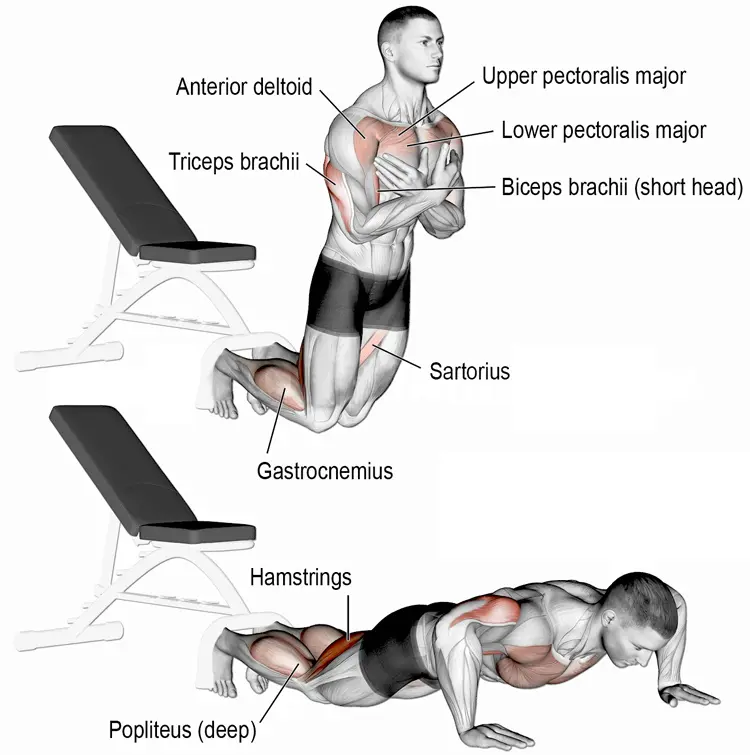
How To Do The Nordic Curl
The Nordic ham curl goes by many names such as the Russian curl/lean or bodyweight curl to name a few. It’s an underrated hamstring and lower posterior chain movement. If you have limited equipment or even if you want to change up your hamstring exercises, the Nordic ham curl is a viable option.
The Nordic curl is great for working the short head of the biceps femoris which only crosses the knee joint. Although, it still works all hamstring muscles of course.
The exercise can either be performed by securing the back of your ankles under a stable object (e.g. machine, loaded barbell, bed frame) or you can have some hold your ankles down. Place something cushioned under your knees to prevent discomfort. Also, you’ll have to find a foot position most comfortable and effective for you.
But, having the feet in a dorsiflexion position (toes raised toward the shin) is recommended. This allows for optimal hamstring lengthening which is ideal for strengthening the muscle at long lengths.
Many injuries occur at long muscle lengths so you can understand why it’s important to maximize strength in this position.
Exercise instructions…
- With the back of your ankles secured while in a kneeling position, position your hands down by your waist but with the palms facing away from you as if you were doing a push-up.
- Bend your hips at a 30-degree angle and do not change this position during the movement while maintaining a relatively upright torso.
- Very slowly lower your body down to the floor and when you reach halfway down, place your hands on the floor to control your body the rest of the way down.
- Push yourself back up to the starting position and repeat
Now, most people who try to do the Nordic ham curl as explained above, will not be able to control the eccentric the entire way down.
Therefore, we recommend wrapping bands around a sturdy object above your head and holding the other end by your chest which will allow you to better control the descent of your torso toward the floor. You won’t collapse due to a weak posterior and you can actually use this as a progression.
‘The Glute Guy’ Bret Contreras highly advises using bands to prevent sinking like a ship during the second half of the lowering phase.
Learn How to Do Nordic Ham Curl
3 Benefits of The Nordic Curl
Here are 3 much-appreciated benefits of the Nordic curl…
1. Increased muscle development
Muscular hamstrings give your upper legs dimension and it prevents your legs from looking flat when viewed from the side. It’s just one of those muscles that add a lot to your overall aesthetics.
2. Strength and function
Strong hamstring muscles can help with physical performance big time. You see, these muscles are heavily involved in the gait or walking cycle. In this cycle, the hamstrings actually store elastic energy during the hip swing forward and just before the knee extends prior to the heel touching the ground. (1)
This stored energy then allows the hamstrings to help propel us forward. Therefore, the best exercises for athletics and general function are those which involve both the hip and knees at the same time. The Nordic curl involves movement mostly at the knee joint but the hips are usually involved to a degree as well.
And although it’s not the best functional exercise when compared to others simply because you’re not on your feet, it’s still an effective hamstring builder. So, include it with your more functional training but don’t use it as a standalone exercise for hamstrings.
3. Injury prevention
The hamstrings are a muscle that is synonymous with injury. This can result from overstretching due to intense physical activity/sports such as soccer, sprinting, etc. Limited flexibility can cause injury as well.
But one 2019 review and meta-analysis of 8459 athletes found that including the Nordic hamstring exercise in injury prevention programs reduced injury by 51%. This is the case for athletes across multiple sports. (2)
Level Up Your Fitness: Join our 💪 strong community in Fitness Volt Newsletter. Get daily inspiration, expert-backed workouts, nutrition tips, the latest in strength sports, and the support you need to reach your goals. Subscribe for free!
One earlier study found that the Nordic hamstring exercise significantly reduced injury incidence in amateur soccer players. However, it did not reduce the severity of the injury.
As mentioned previously, strengthening the hamstrings in a stretched position will only have advantages.
There have also been several studies on the Nordic curl variation which support its efficacy.
Important Hamstring Training Tips
Proper knowledge of hamstring training will ensure you get maximum results while also preventing injury. So, here are our best tips.
Control the eccentric
Whenever you train hamstrings especially, always make sure to control the eccentric (negative) portion of the exercise. We previously talked about the function of the hamstrings to store elastic energy during the eccentric phase of the gait cycle. So wouldn’t it make sense to maximize and develop strength in this phase? Uhh, yeah!
Plus, you’ll maximize hypertrophy as a result and if you plan to prevent injury then you’ll need to not rush the lengthening phase of the exercise.
But being able to control the negative due to a lack of posterior strength is a problem for many people. So again, use bands to decelerate the lowering phase.
Dorsiflex
Because we’re focusing on the eccentric, dorsiflexion is preferred over plantarflexion (toes pointed down away from the shin). Again, it allows for optimal hamstring lengthening during the Nordic ham curl.
Now, some people may have a difficult time with dorsiflexion if doing the Nordic curl on the floor. It can be painful or the ankles may lack the strength to maintain the toes on the floor. So, you can place a foam roller under the shins to solve this issue.
This is especially useful and easier when you have a partner to hold your ankles down.
Bend at the hips for better control
Bending 20-30 degrees at the hips will allow you to better control the eccentric portion. It also allows for better force production of the hamstrings. Maintain this position during the movement.
Challenge yourself
While the banded version of the Nordic ham curl is a great alternative for those who cannot effectively control the descent, why not challenge yourself. Try it without the band and perfect the movement. You’ll experience more of the benefits this way as you become stronger and more proficient.
Nordic Curl Variations
Here are some great functional Nordic ham curl variations.
1. Lat pulldown variation
For this variation, face away from the lat pulldown machine with your legs secured under the foam rolls. Hold a long bar across your traps or upper back and lower yourself down slowly. Return to the starting position and repeat.
Don’t use too much weight as you have to lower your body down. But use enough weight that’ll assist you back up.
Here’s a video example…
2. Loaded barbell variation
Simply load up a barbell with more than your body weight and place a foam roll around the bar for comfort. Perform the Nordic curl as you normally would.
3. Using an exercise ball
For this variation, you’ll need to be on the floor so that you can secure your legs under an object or have someone hold your ankles down. This variation provides a decent amount of support and can be used as a variation or progression.
You’ll start upright with your hands on the ball and then as you descend, your forearms will move over the bar as if you were stretching your arms out over it. Then you’ll return to the starting position. Keep your torso as neutral as possible.
4. Band assisted
We already discussed this variation which is the most popular one for better control during the eccentric. The farther you descend, the more the bands will assist. We recommend placing the bands high above you to effectively benefit from the assistance.
Here’s a video example from ‘The Glute Guy’ himself Bret Contreras…
5. Arms behind your head/body or extended overhead
By placing your hands behind your head/back or extending them above your head during the descent, you increase the difficulty of the Nordic curl. This is recommended for more advanced exercisers and will really torch your hamstrings.
6. Partner assisted
To better control the descent, have a partner sit facing you and when you lower yourself down, place your hands on top of their palms so that they can help you with the lowering and concentric phase.
Nordic Curl Alternative
Stability ball leg curl
The stability ball leg curl is an awesome functional exercise for the hamstrings and even the core muscles. The two-legged version won’t provide as much resistance or a challenge but it’s easier for people who may not be able to do the basic Nordic curl or its variations.
You’ll lie on the floor with your feet on the ball and flex your hamstrings so that your feet move toward your butt. You also have to do some balancing which improves stabilization.
Try it using one leg for even more of a challenge and benefit.
3 Common Mistakes
Here are three common mistakes with the Nordic curl which will limit its effectiveness.
1. Not getting a full range of motion
In order to benefit from the exercise, you must get full knee extension which means your thighs should darn near be flat on the floor or pad. Never stop short or use your arms to push yourself up too soon. Use a progression or assistance if you have to.
2. Dropping down
If you simply allow your torso to drop down and use your arms to catch your body without control, then you’ve wasted the movement. The whole purpose of the Nordic curl is to maximize the eccentric strength.
3. Bending/leaning too much
Again, the hips should be bent at a 30-degree angle and you don’t want to deviate from this at all during the movement. By bending at the hips too much you’re shortening the hamstring stretch.
Frequently Asked Questions
What is the Nordic ham curl?
It’s a bodyweight lower posterior chain exercise that targets mainly the hamstring muscles.
It’s done by securing the back of the ankle and lowering the torso slowly to take advantage of the eccentric portion of the movement.
What muscles does the Nordic ham curl work?
The Nordic ham curl works primarily the hamstrings although the glutes and spinal erectors are also engaged during the movement.
What is the Nordic ham curl good for?
The Nordic ham curl is a great exercise for building muscle and strength, improving performance, and preventing hamstring injury.
What are some effective Nordic curl variations?
Some effective variations you can use are the lat pulldown machine, loaded barbell, band, exercise ball, and partner-assisted Nordic curl to name a few.
Who can benefit from the Nordic ham curl?
Anyone looking to develop their hamstrings and increase the chances of preventing injury. The hamstrings are a commonly injured muscle and research has shown the Nordic curl to reduce the potential for injury by 51% in athletes.
The Nordic curl is also effective for sports/physical performance as the hamstrings are important for walking, running, sprinting, etc.
Is the Nordic curl safe for everyone?
If you do it properly and know your capabilities then it’s a safe exercise. Use assistance and/or a partner to help you during the movement and make sure you have a proper setup.
For someone with a back or hamstring injury, we recommend not doing this exercise.
What's the difference between the Nordic curl and glute-ham raise?
The Nordic ham curl involves a slow and controlled eccentric with an assisted concentric. It also has a shorter range of motion and there are many different variations.
The glute-ham raise is performed on a platform that allows for a larger range of motion. It also has a concentric portion where the exercise contracts the hamstrings to return to the starting position.
Both exercises work the same muscles although the glute-ham raise focuses more on the glutes than the Nordic ham curl.
Wrapping Up
And it’s that simple! Well, sort of because the Nordic ham curl takes a little getting used too. It’s definitely a challenging movement that not everyone can do on the first try. But you can work up to it using some assisted variations.
It has shown to be an effective muscle and strength builder plus the injury benefits are another advantage to the Nordic ham curl. So, whether you have limited equipment or want to change up your routine, we give it a thumbs up!

